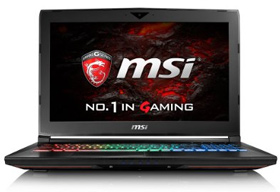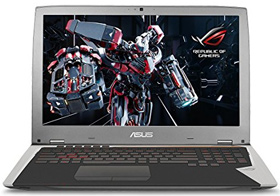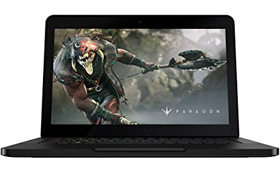We gathered 11 of the best-rated gaming laptops available for 2020, and put them through 4 months of testing. As a small group, this was a big deal for us. We didn't accept any freebies or demos, so this was a cost and labor intensive process, and we hope that you appreciate the unbiased outcome that results!
We don't just fire it up and run it through standard graphics, gaming, battery, and hard drive speed, we want to make sure that the systems are reliable as dedicated workhorses. You want a system that is both powerful enough to bring your gaming to the next level, but also reliable enough to keep around for several years and use flexibly as tasks demand.
That being said, we ran every laptop through the standard set of tests, and then kept them around for a while to see how things turned out. Did the system maintain its speed and stability? Did it show high build quality and reliability? Was it comfortable to use for writing that term paper, and have good enough color accuracy and gamut for those occassional Reddit photoshop battles? These things matter to most users, so we made sure things were not just excellent out of the box, but also excellent over continued practical use.
Our testing methodology: Like other websites, the first thing we do is fire up the laptops and finish the Windows installations, and then run them through the standard set of tests. For us, these include 3DMark FireStrike and Ice Storm to test the graphics and gaming capabilities, GeekBench 4 to test processor and memory speed, WebGL graphics test for frame rates, and standard color balance, color gamut, and display brightness tests. We aren't going to bore with you with all the data from these tests, but rather just take them into consideration when making our overall recommendations. After running these standard benchmark tests, we tested performance with gaming and non-gaming tasks. For gaming, we logged over 1100 hours of Battlefield 1, Call of Duty Black Ops, Fallout 4, GTA V, Overwatch, Just Cause, Doom, and Elder Scrolls V Skyrim. That's a lot of Doritos, Mountain Dew, and eye drops. We also checked out compatibility and performance with the Oculus Rift and HTC Vive virtual reality headsets. We also did a ton of standard internet browsing, Excel and OpenOffice spreadsheet processing with arrays and formulas, word processing, and Photoshop design work.
What we found: Perhaps not surprisingly, the best gaming laptops for the year also tend to be the most expensive and best reviewed laptops around. There were some exceptions to that, included as the best bang for the buck options on the market: high performance at a reasonable cost. We also found that if your plan is to occassionally use the laptop as a complete gaming rig without attaching to an external monitor, then you will definitely want one with a larger screen. There are some great 13" options out there, like the Alienware R2 13", but for gaming on the laptop alone you'll definitely want a larger display size. Of course, with the larger displays you compromise a bit on portability, so keep that in mind if you're planning on lugging this back and forth from school/college/work.
Rather than giving you a ranking from 1-5, we've found that each laptop has its own pros and cons that make it better or worse for certain use cases. So we categorize by best overall gaming laptop, best portable gaming laptop, best bang for the buck gaming laptop, and best 17" display gaming laptop. With these categories in mind, here is our list for 2020:
Best Overall 15" Gaming Laptop
 MSI GT62BR Dominator Pro 15.6" Gaming Laptop
MSI GT62BR Dominator Pro 15.6" Gaming Laptop
Overall Rating 
It doesn't get much better than the MSI GT62VR. All 4 of our reviewers had this rig at the top of their list. One put it on his Christmas wish list, and one ended up buying it from us at a small discount. This laptop was a blast, and has the specs to prove it: Nvidia G-Sync non-reflective display with 300 nits brightness and great color rendering (with MSI True Color rendering), a powerhouse Nvidia GTX 1070 GPU, an i7-6700 processor, 32GB of DDR4 RAM, and a super fast 256GB SSD with a 1TB HDD. It's a big (about 1.5" thick), heavy (just over 6 lbs), and somewhat costly (about $2000) beast of a laptop.
What we loved: First, we loved the True Color software, which let us alter color settings across 6 presets, including Gamer and Movie. Second, we loved the display, which with G-Sync technology was truly marvelous: no tearing at high frame rates, smooth like butter transitions, and truly great brightness and color rendering. Third, we loved the VR ready capability: we hooked up the HTC Vive and Oculus Rift and were amazed with how easy it was and breathtaking it looked. Fourth, we saw blazing fast frame rates on the Hitman benchmark, hitting over 150fps at full resolution. Fifth, the keyboard was awesome, with very long travel for a laptop, and a great organization and hand feel. Finally, we liked the Killer software that allowed us to prioritize connections to help reduce packet loss and lag during gaming. After several months, this beast still screamed during gaming, and was as reliable as any other laptop we've tested. If you've got the cash, we say go for it.
What we disliked: Short list on this one. But if we're picky, we think MSI could do a better job with their speakers, which are a bit tinny and have trouble producing lower frequency sounds. Given all the power in this thing, it also shouldn't be surprising that battery life wasn't exceptional. If you turn down the display brightness, you will get about 5 hours with mundane tasks. With gaming, expect to cut that number at least in half.
Check it out at Amazon, usually under $2000 depending on configuration.
Best Overall 17" Gaming Laptop
 ASUS ROG G710VI 17.3" Gaming Laptop
ASUS ROG G710VI 17.3" Gaming Laptop
Overall Rating 
ASUS really hit the ball out of the park with this huge, hulking, beast of a gaming laptop that will leave others envious and in your dust. They spared nothing in building this rig, and it shows down to the last detail. A bit large for our tastes, but if you've got the space and the biceps to lug it (and its enormous charger) around, then this might be the perfect gaming laptop for you. Let's talk specs, because there's a lot to consider here. This rig boasts the latest generation Nvidia GTX 1080 (!) graphics card with G-Sync and Pascal VR capabilities, a screaming (and unlocked) Core i7-6820HK processor, overclocked 64GB DDR4 RAM, and a super fast 512GB SSD. Did we mention the display? This intense 17.3" FHD display knocked our socks off. It has a screaming fast 120Hz refresh rate, IPS quality color rendering, and super wide viewing angles that stunned even our most stringent reviewers. ASUS went all out with the graphics and screen here, and the gameplay was truly outstanding as a result. This is definitely the smoothest, best color rendering, truly vivid display we reviewed this year, and we're happy to recommend it to anyone with the budget to go all out.
What we loved: Nearly everything. We loved that hooking this up to VR was a breeze and it was compatible with the Oculus Rift and HTC Vive out of the box, with excellent performance on both units. Second, we loved the brushed aluminum form factor with the anti-ghosting keyboard, even if the chassis is 1.7" thick and 8.2 pounds! Third, did we mention how obsessed we are with this display? It's definitely one of the best on the market, with fast tear-free performance at 120Hz, a phenomenal viewing angle, close to 300 nits brightness, and great color rendering. And paired with the GTX 1080, it's damn fast. We saw Hitman running at 111fps, and GTA V running at 117fps. Fourth, this thing cranks on games and doesn't even break a sweat, staying only luke warm to the touch the entire time. Finally, speakers and sound reproduction are surprisingly great for a laptop, and the number and type of ports is really versatile: LAN, mini DisplayPort, full HDMI, three USB 3.0 ports, and two USB Type-C ports (yes, for Thunderbolt 3 as well). After 4 months of testing, this is the only laptop in the group that wasn't attached to external speakers. And it was, hands-down, the go-to laptop for gaming during those months. Not something for gaming-on-the-go (whatever that means), but an outstanding desktop replacement gamer.
What we disliked: Well, it's big, but you know that already. The battery life was only about 4 hours with the screen very dim and only doing mundane tasks, and less than 2 hours with gaming. That's not surprising with this GPU and screen size. The screen was also a bit dimmer than some others, but nothing to write home about.
Check it out at Amazon, usually starting around $3500.
Best Portable Gaming Laptop
 Razer Blade 14" HD Gaming Laptop
Razer Blade 14" HD Gaming Laptop
Overall Rating 
Leave it up to Razer to figure out how to squeeze an Nvidia GTX 1060 into a laptop that's only 0.7" thick and 4.2 pounds. Sure that's not in the league of ultraportable laptops, but don't hold your breath waiting for a true gaming laptop to ever make it into that category. This is a powerhouse of a laptop with specifications that will cause jealousy in contenders, and keep you running at the peak of your game wherever your travels take you. Start with the Nvidia G-Sync compatible matte 1920x1080 display with about 290 nits brightness with excellent color reproduction, a superstar Nvidia GTX 1060 GPU, an i7-6700HQ processor, 16GB DDR4 RAM, and a super fast SSD that comes in three capacities: 256GB, 512GB, or 1TB. It's packing a lot of punch under the hood for such a streamlined, lightweight laptop. The super versatile laptop usually starts around $1900 or so, and goes up for the larger SSD capacities.
What we loved: First, we loved the sleek black aluminum chassis, with looks more like a traditional laptop than a powerhouse gaming rig. It's the ultimate sleeper system that won't look completely ridiculous in the classroom or boardroom. Second, the G-Sync technology did a fantastic job at high frame rates keeping the tearing at bay and making transitions look phenomenal and highly detailed. Even at higher frame rates, the color reproduction looked accurate and crisp. Third, the VR ready Pascal GPU made connecting and using the HTC Vive and Oculus Rift exceptionally easy, and the results were brilliant. Fourth, we saw some very impressive above-average frame rates on certain games (like GTA V), and some truly exceptional frame rates (180+) when benchmarking with Hitman. Fifth, the Razer system has some great keyboard software that allows you to customize individual keys to maximize your gameplay. Definitely a great touch for serious gamers. Finally, we appreciated the relatively long battery life. On low screen brightness with mundane tasks, we were able to get over 7 hours of continuous use. During gaming with higher brightness and higher fps settings, that number dropped dramatically down to under 2 hours. That's to be expected, especially with the new Pascal Nvidia GPUs. After a few months of use, we have to say it got better with time: lugging around some of the beast-sized gaming laptops was tiring and annoying. In many cases, the chargers were nearly as large as the laptop and things got a little hefty for our tastes. This laptop was a considerable outlier, keeping us quite happy with its sleek form factor.
What we disliked: Due to its svelte form factor, there were some disadvantages. First, unlike its bigger brothers you aren't going to fit the giant cooling fans and plumbing that you'd like to have in a gaming laptop. We never had any real heat dissipation issues, though the aluminum chassis did get quite warm to the touch at times. Second, the slimmer chassis also limits the number and type of ports. You're getting a Thunderbolt 3 port (which will get you the Razer Core down the road), three USB 3.0 ports, a full size HDMI port, and headset plug. There's also a Kensington lock hole, and of course the power port on the far back left side. So only positives when it comes to blazing gaming performance, and the only limitations are directly related to its slimmer profile; if you ask us, the benefits of the slimmer profile definitely outweigh the limitations.
Check it out at Amazon, usually starting around $1900 and climbing with larger SSDs.
Best Bang-for-the-Buck Gaming Laptop
Overall Rating 
When I first got into gaming, I was a first-year college student with big dreams, but living on a restricted budget. I wanted the ultimate gaming laptop, with all the best specs and features. I did my research and realized that would cost me about $2500, which was way out of my budget. Luckily there are some decent contenders for laptops under $1000 that can do a very nice job supporting gaming with even the most discerning users. Enter hte Asus K501 series, which usually prices out around $850 and has some great features and performance. Coming in at slightly thicker than the Razer, the Asus is 0.8" thick, but otherwise has a nice streamlined profile suitable for both gaming and everyday use in the classroom or boardroom. But don't let the sleek brushed aluminum chassis fool you, there is some serious power hiding in there. Start with the Nvidia GeForce GTX 960M graphics card, fast 512GB SSD storage, an i7-6500 processor that caps out at 3.1GHz, and 8GB DDR4 (expandable if you grab another 8GB DDR4 stick), and you've got yourself an inexpensive and well-equipped gaming laptop. The matte display showed decent color reproduction and brightness around 250 nits. Nothing like the MSI or Razer options, but pretty good at this price point.
What we loved: First, we loved the sleek brushed aluminum look chassis, which looks like a traditional no-frills laptop that fits in anywhere you go. Second, we really like the bang for the buck on the spec sheet: a great processor and GPU, a decent panel, a fast SSD, and for a great price. We're all lucky to be living in an age where you can get a decent and reliable gaming system for under $900. Third, we loved the battery life. ASUS uses a GPU management software that throttles back the GPU power consumption when you're not gaming, which helps quite a bit, bringing battery life up around 7 hours with a dim screen and mundane tasks. With gaming at regular screen brightness, expect about 3 hours battery life. Finally, we want to mention that the speakers are actually pretty reasonable on this rig, no complaints here (though your neighbors might). Overall, this is a serious gaming system that will not put an enormous dent in your wallet, shows decent reliability, and is housed in a sleek portable chassis.
What we disliked: We aren't thrilled with the fact that it comes with only 8GB RAM, which showed when multi-tasking, though you can indeed expand on it (as mentioned above). We also had some heat management problems that impacted serious gaming. Not a laptop for the lap, this is best used on hard-top desk for anything but basic office tasks. Finally, we found some limited fps performance in some games like GTA V and Fallout. Note that this should be expected in a gaming system under $1500-1800, but it's worth mentioning.
Check it out at Amazon, usually starting around $850.
